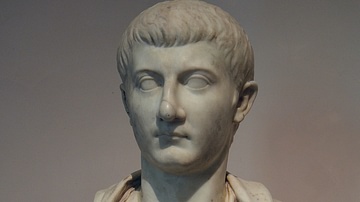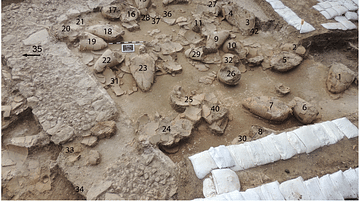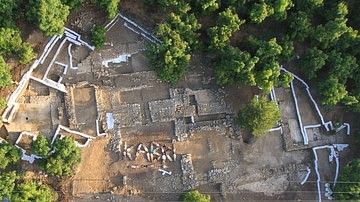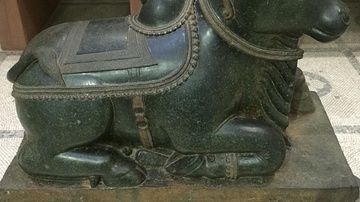Search Images
Browse Content (p. 1513)

Image
Second-style Pompeian Fresco
Second-style Pompeian fresco in the House of Augustus (Domus Augusti) on the Palatine Hill in Rome. The vividly-coloured fresco depicts a two-storey architectural facade in blue, white, yellow and red with perspective rendition of colonnades...

Image
Drusus Julius Caesar
Drusus Julius Caesar (Drusus the Younger) was was the only child of Roman Emperor Tiberius and his first wife, Vipsania Agrippina. He was also a maternal cousin of the Caligula, a paternal cousin of Claudius and a second cousin of Nero...

Image
Mosaic in Opus Vermiculatum
Roman mosaic with white tesserae featuring a central panel (emblema) in opus vermiculatum (micro tesserae), Floor of the triclinium of a Roman villa in Via Ardeatina in Rome, first quarter of the 1st century BCE. The above panel depicts...

Image
2013 image of labelled wine jars in first Tel Kabri wine cellar towards the southeast
An image of the wine pithos at Tel Kabri's Area D-West in situ during the 2013 excavation. The pithos were excavated out after the photo and this storage room is now covered over for conservation purposes. For purposes of the excavation...

Image
The Punishment of Marsyas
Statue in red marble depicting the punishment of Marsyas, a satyr who dared challenge Apollo to a music contest. Marsyas lost and Apollo had him tied to a tree and flayed him alive. The statue was found at the Villa Vignacce in southeastern...

Image
Tauroctony Relief
Tauroctony relief in white marble depicting Mithras slaying the bull in a grotto. It was found South of Monastero near Aquileia (Italy). Now in Vienna Kunsthistorisches Museum, Austria. From the 2nd half of 2nd century CE.

Image
Great Cameo of France
The Great Cameo of France is a five-layered sardonyx cameo divided into three levels which depicts members of the Julio-Claudian dynasty, circa 23 CE. The Great Cameo of France is the largest cameo to survive from the ancient world. It...

Image
Tel Kabri location within Israel
A map showing the location of Tel Kabri within the borders of the modern State of Israel.

Image
Overhead shot of Tel Kabri
An image of Tel Kabri's Area D-West as it was at the end of the 2013 season. The excavators have lain down in Ceremonial Hall 611 and are spelling out the name of the site for a photo competition that was being held at the time. The top of...

Image
Nandi Sculpture
A serpentine stone sculpture of Nandi, the sacred bull calf and vehicle of the Hindu god Shiva. The Deccan, India, 1550-1650 CE. (Victoria & Albert Museum, London)